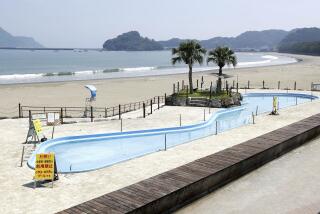Japan Sees Quake Risk at Nuclear Sites
- Share via
TOKYO — Japan’s recent accident at a uranium processing plant, which exposed safety flaws in the country’s aggressive nuclear energy program, has renewed concerns that an earthquake could trigger another crisis if it were to strike close to reactors or nuclear-related facilities.
Japanese activists and some seismologists point out that some of this earthquake-prone archipelago’s 51 nuclear reactors are built in areas where quakes are likely. They also contend that four dozen nuclear-related treatment and processing facilities could also be prone to radiation leaks in the event the “big one” strikes.
“I think the situation right now is very scary,” says Katsuhiko Ishibashi, a seismologist at Kobe University. “It’s like a kamikaze terrorist wrapped in bombs just waiting to explode.”
Ishibashi argues that the government’s prime criteria for judging whether nuclear power plants are safe are “absolutely wrong” from a seismological standpoint. Among the factors used to decide where to locate plants are past earthquake data and proximity to known fault lines and to the ocean, which is used to cool reactors.
Ishibashi predicts that the area of a nuclear plant in Shizuoka prefecture in central Japan--while not considered part of an active seismic region--will be the site of the next big quake. A fifth reactor is under construction at the plant.
Earthquakes often occur in areas where faults have not been found, which was the case in the 1995 temblor in Kobe.
“It is wrong to give too much weight to active fault research for measuring earthquake possibilities at nuclear power plant sites,” Ishibashi says. “Active faults reflect only a part of the whole earthquake state, just like a tail of an animal.”
Japanese and international regulators, as well as the Japanese companies building the reactors, note that earthquake data are taken into consideration in the placement of reactors, which they say can withstand earthquakes as great as magnitude 8.5.
If an earthquake hits a plant, safety devices will function even if other facilities are damaged, and the reactor will automatically stop, cool down and then prevent leakage, says Yuji Kurotani, senior examiner in Japan’s Nuclear Power Safety Examination Division.
An earthquake larger than 8.5 could spell trouble, however.
“Then it will be the same as Chernobyl,” says Kurotani, referring to the world’s worst nuclear accident, the reactor meltdown in Ukraine in 1986. “But that kind of case will never happen.”
Unlike in Japan, a country lacking in natural resources that is aggressively beefing up its nuclear power program to supplant reliance on imported fuels, the issue of vulnerability to earthquakes hasn’t come up much in the U.S. in recent years. No nuclear reactors have been built since the late 1970s, after cost overruns and the Three Mile Island nuclear accident all but ended nuclear-energy expansion.
The International Atomic Energy Agency says none of the world’s 434 nuclear power plants have experienced major problems that were due to earthquakes, a statistic that illustrates the “strength of construction which is rightly part of their basic design,” says spokesman David Kyd.
He says nuclear power plants are built with “tremendously strengthened foundations and structural features to ensure that they can withstand the biggest conceivable earthquake.”
“This is why nuclear power plants in both Japan and California, for example, and more recently in Taiwan, have ridden out fairly major earthquakes without damage,” Kyd says.
But Ishibashi contends that, even if new faults are found--as in the case of Shimane nuclear plant in western Japan--the government doesn’t disclose details or revise plans.
A group of about 300 local activists has been suing to block the construction of a planned third reactor at the plant.
“There were supposed to be no faults, which is why the plant was approved in the first place under the government’s safety guidelines,” says Yasue Ashihara, who is spearheading the opposition group.
“Since now we know that the active fault exists around the reactors, the facts indicate that they no longer meet the safety guidelines,” Ashihara says.
Hisako Ueno of The Times’ Tokyo Bureau contributed to this report.
More to Read
Sign up for Essential California
The most important California stories and recommendations in your inbox every morning.
You may occasionally receive promotional content from the Los Angeles Times.













